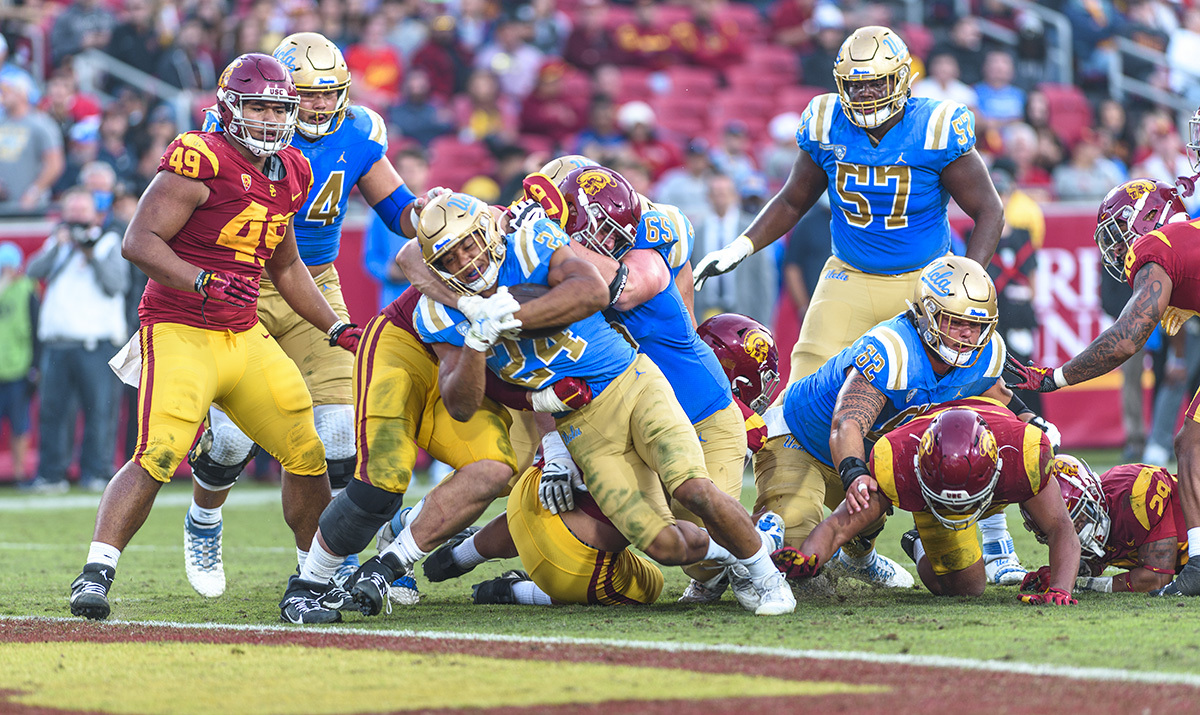Christon Chronicles: Big Ten membership may not mitigate all of UCLA Athletics’ financial challenges

UCLA athletic director Martin Jarmond watches a water polo game. (Jeremy Chen/Assistant Photo editor)

By Jon Christon
July 1, 2022 4:36 p.m.
This post was updated July 4 at 8:41 p.m.
It’s official: UCLA is joining the Big Ten in 2024.
After a day full of rumor and conjecture, UCLA Chancellor Gene Block and athletic director Martin Jarmond announced the school’s decision to leave the Pac-12 and join the Big Ten on Thursday afternoon.
What does that mean? Zooming out, it likely spells the end to the existing college sports landscape. The Power Five conferences – the Pac-12, Big Ten, Southeastern Conference, Big 12 and Atlantic Coast Conference – will most likely evolve into some form of the “Power Two,” constituting a pair of 20-team megaconferences. It was likely already heading in this direction after Texas and Oklahoma announced their move to the SEC in 2021, and UCLA’s and USC’s decisions just accelerated the process.
But what about at a micro level? What motivated UCLA to make this move? Why now?
“Seismic changes in collegiate athletics have made us evaluate how best to support our student-athletes as we move forward.
… Big Ten membership offers Bruins exciting new competitive opportunities and a broader national media platform for our student-athletes to compete and showcase their talents.
… Entry into the Big Ten will also help ensure that UCLA preserves and maintains all 25 current teams and more than 700 student-athletes in our program.
… Big Ten membership equates to better television time slots for our road games, but the same number of home games either at the Rose Bowl, in Pauley Pavilion or other UCLA venues,” Block and Jarmond said in the official release.
Translation: Our athletic department is $102.8 million in debt, and we need money now.
On the surface, this is nothing to sneeze at. UCLA Athletics’ goal is to make money for the university, after all, and this will certainly help with that.
The Big Ten made around $235 million more than the Pac-12 in 2019-2020 – the last year before the COVID-19 pandemic affected earnings. Big Ten member schools took home $54.3 million compared to $33.6 million for Pac-12 member schools in the same year. This disparity will become even more exaggerated in the coming years, with the Big Ten expected to ink a new television rights contract that will exceed $1 billion per year.
According to Jon Wilner of The Mercury News, UCLA could make more than $100 million annually in media rights as a member of the Big Ten.
Suffice to say, the financials check out.
So think of this as a mulligan for UCLA and its athletic department – a second chance, if you will.
UCLA will get a fresh start with a clean financial sheet. It likely won’t have to cut any athletic teams with the influx of cash in the near future and can focus on reinvesting its earnings into its student-athletes through various name, image and likeness programs.
But the Bruins could also be playing with fire. There is no guarantee this ensures the long-term prosperity of the program.
UCLA is not blameless in its financial shortcomings. Comparable Pac-12 schools – such as California – profited even amid the pandemic.
UCLA football has struggled to fill seats at the Rose Bowl, and it’s hard to make consistent money without a sound fanbase. Sure, the program had a bounce-back season in 2021, but that came after five straight losing seasons. With the significantly increased level of competition that comes with Big Ten football, there’s nothing stopping UCLA from falling into another funk and missing out on potential revenue in the nation’s most profitable collegiate sport.
Furthermore, travel costs in all sports will increase significantly with regular trips to the East Coast. Football only has a handful of road conference games per season, but that number adds up elsewhere.
In short, this decision is risky. The money will help tomorrow, but it’s not guaranteed to stabilize an unstable athletic program.
While UCLA got a head start in the future of college sports Thursday, the Big Ten won’t be a cure-all – just like the Pac-12 wasn’t completely to blame.



